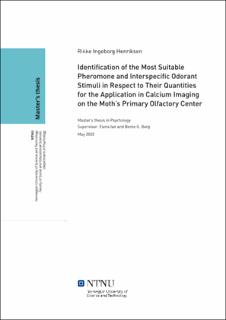| dc.contributor.advisor | Ian, Elena | |
| dc.contributor.advisor | Berg, Bente G. | |
| dc.contributor.author | Henriksen, Rikke Ingeborg | |
| dc.date.accessioned | 2021-09-13T16:18:03Z | |
| dc.date.available | 2021-09-13T16:18:03Z | |
| dc.date.issued | 2020 | |
| dc.identifier | no.ntnu:inspera:55448216:37053826 | |
| dc.identifier.uri | https://hdl.handle.net/11250/2776034 | |
| dc.description.abstract | «Calcium imaging» teknikken som ble brukt i dette prosjektet tillater for undersøkelse av andre-ordens projeksjonsnevroner (PN) i det primære luktsenteret i hjernen til møllen Helicoverpa armigera. Fokuset i dette prosjektet lå på et spesifikt område i antenne loben (AL), «the macroglomerular complex» (MGC), som er ansvarlig for prosessering av informasjon gjeldende hunn-produserte komponenter. For å kunne beskrive responsprofilen til projeksjonsnevronene i MGC, ble to feromoner og én interspesifikk komponent brukt som luktstimuli. I tidligere gjennomførte «calcium imaging» eksperimenter, inkludert de gjennomført i den kjemosensoriske laben, har relativt høye konsentrasjoner blitt brukt. Disse konsentrasjonene er så høye at de ikke kan etterligne signaler som oppstår i møllens naturlige miljø. Målet med dette prosjektet var å identifisere en mer relevant stimuluskonsentrasjon for bruk i «calcium imaging» eksperimenter. Retrograd farging av den mediale antenne lobe trakten (mALT) sine projeksjonsnevroner ble utført for å kunne undersøke deres aktivitet i respons til ulike konsentrasjoner fra 10-3-10-8 av to feromonkomponenter, cis-11-hexadecenal (Z11-16:Ald) og cis-9-hexadecenal (Z9-16:Ald), og en interspesifikk komponent, cis-9-tetradecenal (Z9-14:Ald). Projeksjonsnevroner i MGC enhetene viste høy sensitivitet til disse komponentene og var i stand til å detektere relativt lave mengder av komponenter sammenlignet med tidligere brukt stimuli.
Resultatene fra prosjektet demonstrerer at tidligere brukte konsentrasjoner er for høye og at konsentrasjonen 10-4 er tilstrekkelig for å fremkalle sterke nok responser i alle MGC enhetene i antenne loben. I tillegg ble metodologiske svakheter identifisert under prosessering av rådata. Noen preparasjoner viste avvik mellom rådata og prosessert data i KNIME programvare. | |
| dc.description.abstract | The calcium imaging technique used in this project allows for the investigation of the second-order projection neurons (PNs) confined to the primary olfactory center of the moth Helicoverpa armigera brain. The focus of the study was on a specific area of the AL, the macroglomerular complex (MGC), responsible for the processing of information regarding female produced components. In order to describe the response profile of the MGC PNs, two pheromones and one interspecific component were used as odor stimuli. In previous calcium imaging experiments, including those performed in the Chemosensory lab, quite high concentration stimuli were used, which were hardly close to naturally occurring signals in the moth olfactory environment. The aim of the present study was to identify a more relevant stimulus concentration for the usage in calcium imaging experiments. In order to do so, retrogradely stained medial antennal lobe tract (mALT) PNs were investigated on their activity in response to the concentrations ranging from 10-3 to 10-8 of two pheromone components, cis-11-hexadecenal (Z11-16:Ald) and cis-9-hexadecenal (Z9-16:Ald), and one interspecific component, cis-9-tetradecenal (Z9-14:Ald). PNs in the MGC units showed high sensitivity to these components and were able to detect relatively low quantities of components in comparison with the previously used stimuli.
The results obtained in this project demonstrate that the previously used concentrations are indeed too high, and the concentration 10-4 is suitable enough to elicit strong responses in all the investigated MGC units in the AL. In addition, methodological weaknesses were identified during processing of raw data, where some preparations showed discrepancies between raw data and processed data in KNIME software program. | |
| dc.language | | |
| dc.publisher | NTNU | |
| dc.title | Identification of the Most Suitable Pheromone and Interspecific Odorant Stimuli in Respect to Their Quantities for the Application in Calcium Imaging on the Moth’s Primary Olfactory Center | |
| dc.type | Master thesis | |
